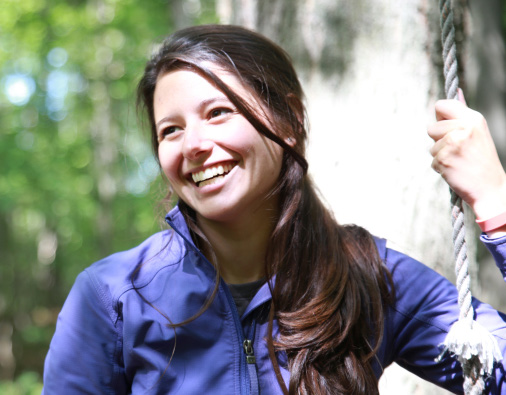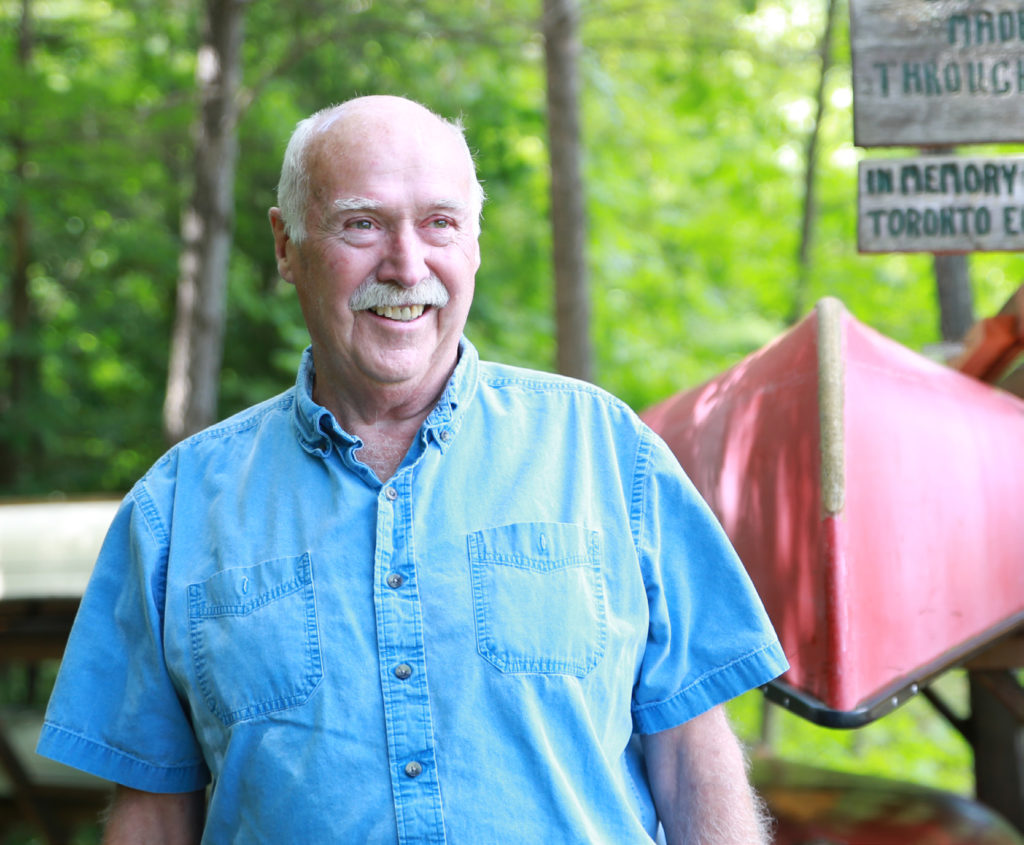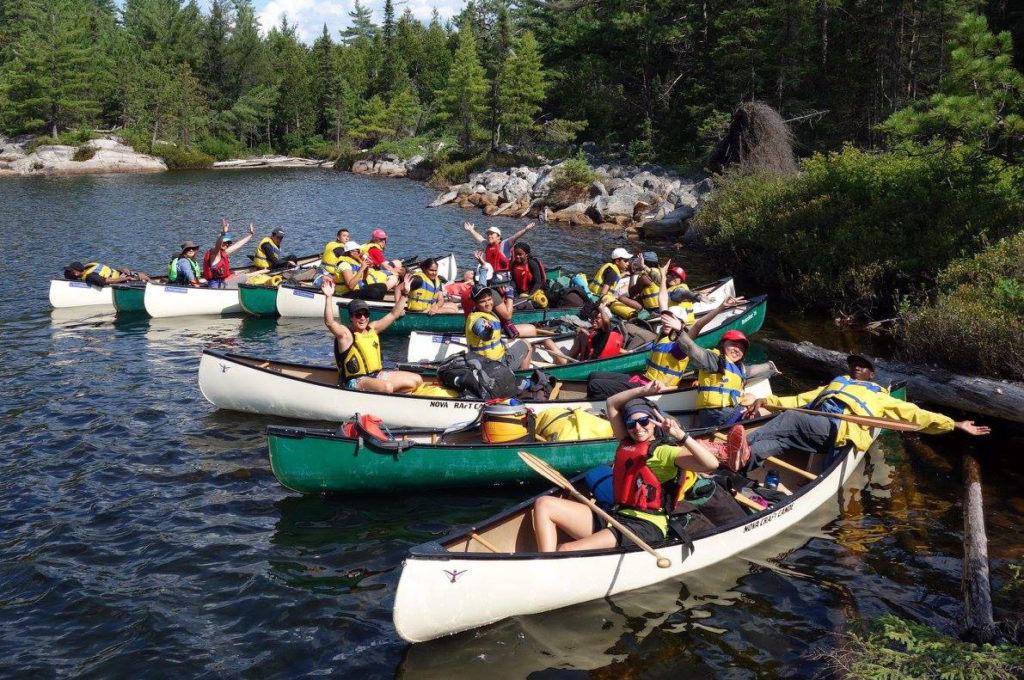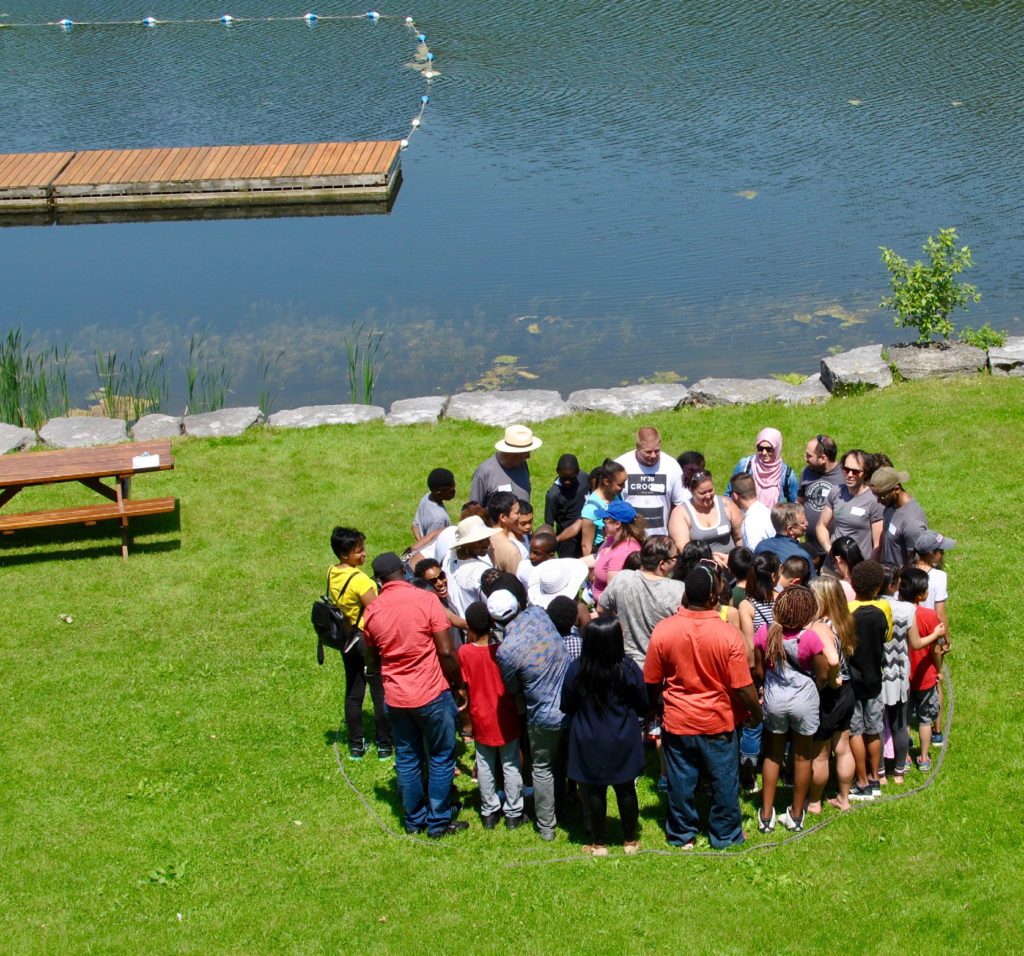It is a very Canadian scene, a glimmering dark lake carries a reflection of the surrounding canopy, a wooden dock juts out towards a buoyed rope, while cabins and a lodge cling to a hillside, hidden in the long shadows of the forest. It is quiet, except for the dance of birds and bugs. Where is this, Bonnechere? No, it is the Whitchurch Forest.
Our hosts are Founder & Chair Jim Hayhurst Sr. and President Melissa Millward of Trails Youth Initiatives. Jim, with receding white hairline, trimmed white mustache and a caring demeanor is a little like Santa Claus – or at least, the way Santa Claus could have been without the extra weight, rosy cheeks, and commercial attachments. Mel is beaming with enthusiasm and warmth, with long brown hair and brown eyes – and a wide, ever-present smile. Mel is from Brampton, and then has lived and worked all over the world. She is ageless – somewhere between youth and wisdom.
We sit down with Jim and Mel – and the two camp dogs – in the window lined lodge office-slash-boardroom and listen as they tell the story of Trails Youth Initiatives. At Trails they challenge and equip at-risk youth to become contributing members of the community. Their success rate is 90%, which applies to both the retention rate and to the students that go on to college or university.
Jim, a retired advertising man and former chair of Outward Bound Canada, tells a heart wrenching story about bringing a group of children from Harlem to Algonquin:
He sat back and said that “the seeds of Trails were planted in 1992 when Peter Dalglish, the founder of Street Kid’s International, asked me if I would work with him in Africa. I replied-”
‘Thanks Peter, but there are a lot of challenges with vulnerable youth in Toronto, and I would rather volunteer here and try to make a difference in my own home town…’
“The strategy was develop self confidence, then the skills and knowledge to carry them forward. The execution was based on lessons from other programs to create a Four Seasons, Four Years, For Life Programme that had never been done before.”
Jim and Mel alternate leading the conversation. First, they taught what Trails isn’t: They do not shotgun problems with broad fixes. They do not measure commitment in political cycles, or as a single summer hiatus. They do not seek financial support from any level of government, and never have. They do not view the problem of at-risk children from afar; from bureaucracy or academia. They are not global or national in their approach.
The stated goal of Trails is to ‘have a big impact on a few, rather than a little impact on many’. Their program is long-term and systemic. Trails is focused on the GTA and their approach is hands-on. They are a registered charity that is 100% privately supported. They have a 25-year track record of success.
Trails recruits participants from 6 feeder schools that are at the bottom 15% of the Learning Opportunity Index. Furthermore, Trails does not recruit the ‘upper crust’ from these schools, or those that have already fallen through the cracks; they use a triage approach to identify and help kids succeed – kids that would have fallen through the cracks without assistance, but can succeed with it.
Each student is required to pay $100 a year to ensure that there is family buy-in. “$100 is a lot of money to a financially constrained family,” says Jim, “but if they can’t afford it, we find a way to make it work”. The true cost of each student per annum is about $7,200. Trails has operated a year-round camp on a 143-acre forested site in Whitchurch-Stouffville for the past 20 years.
Students at Trails access a wide variety of outdoor activities such as skating, yoga, canoeing, swimming, snowshoeing and high ropes, and indoor teachings, such as conflict resolution, wellness education, interviewing skills and resume writing. In the fourth year, they take a trip to Algonquin. They can earn 4 high school credits while enrolled, which further proves program legitimacy.
Their site is not unlike any other overnight camp – forest sounds and earthen smells, mosquitoes and frogs, a main lodge, residential cabins, three lakes, many kilometers of hiking trails, campsites and playing fields. In some respects, it is in better shape than most, as the cabins are clean, and insulated for year-round use.
Each year Trails welcomes twenty 12-year olds to embark on their four-year journey (10 boys & 10 girls). In addition, there is an optional fifth year and sixth year LIT/FIT program where students can further develop leadership and life skills. Further, they can access bursaries to attend post-secondary education.
Trails supports a total of about 115 youth each year. “We just helped one of our students with his Masters degree and his PhD program,” says Jim.
There has never been an incident between Trails students and the local community; for the most part, neither knows that the other exists. Trails prizes its privacy. They have not asked for anything, but they have supported the local economy.
“We’re often asked ‘if Trails has such a great impact on these kids, why don’t you enroll more kids?’ And so we are going to do a test. This past summer we recruited an additional 20. We are evaluating the impact on our Programme,” says Mel.
It’s a bold move toward growth and a little bit astray from their mantra, but when something works this effectively – I ask, ‘why isn’t it everywhere?’
I say ‘perhaps this article will help you find a new batch of supporters.’ Jim smiles and says “that’s not how it works.”
It is quietly apparent that Jim was weary of the interview idea, but remained open to Mel’s enthusiasm. Past interviews have only resulted in myriad of requests to get children – from above average schools – enrolled in the program, “and that’s not how it works either,” says Jim, “we have a plan, an objective and a track record. We will stay the course.”
Trails has accomplished much with their small $800,000 annual budget; 77% is spent on programming, the rest on fundraising and administration.
Get Involved
Trails can use your help. Sponsor a student, become a corporate donor, organize a group of volunteers, or dedicate event revenues to this local charity. For more information see www.trails.ca.




